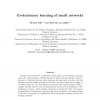Free Online Productivity Tools
i2Speak
i2Symbol
i2OCR
iTex2Img
iWeb2Print
iWeb2Shot
i2Type
iPdf2Split
iPdf2Merge
i2Bopomofo
i2Arabic
i2Style
i2Image
i2PDF
iLatex2Rtf
Sci2ools
COMPLEXITY
2008
2008
Evolutionary learning of small networks
Results are presented of a simulation which mimics an evolutionary learning process for small networks. Special features of these networks include a high recurrency, a transition function which decreases for large input activities, and the absence of tunable weights attached to the lines - the line is either there (weight 1) or absent (weight 0). It is remarkable that already these simple systems exhibit a complex learning behavior and the phenomenon of punctuated equilibrium in the evolutionary process. These findings should be of interest for both, the general understanding of evolutionary dynamics and, more specifically, the understanding of the role of recurrence in combination with non-monotic response patterns for learning processes. 1
Complex Learning Behavior | COMPLEXITY 2008 | Evolutionary Learning Process | Large Input Activities |
| Added | 09 Dec 2010 |
| Updated | 09 Dec 2010 |
| Type | Journal |
| Year | 2008 |
| Where | COMPLEXITY |
| Authors | Thomas Filk, Albrecht von Müller |
Comments (0)

